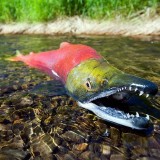Regional politicians in jurisdictions along Howe Sound are calling for a bigger role in the review of a major proposed gravel mine at McNab Creek. Several Sunshine Coast regional directors and councilors have recently stepped forward with concerns about the lack of local government involvement in the project’s environmental review – currently being carried out under the federal Canadian Environmental Assessment Act.
Burnco Rock Products, Ltd. of Calgary wants to build a 77 hectare, 55 metre deep gravel and sand pit in acknowledge fish and wildlife habitat. The company estimates it can extract 1 – 1.6 million tonnes of gravel per year for 20-30 years from the property, rising to as much as 4 million tonnes in some years. The size and potential environmental impact of the proposal have local politicians and citizens raising red flags. A local citizens’ group, The Future of Howe Sound Society, is also concerned the project has slid under the radar thus far and is urging the public to comment on the proposal by the end of the week, when the first public comment phase closes.
Directors of the Sunshine Coast Regional District expressed surprise at a January 19 meeting that the public comment period for the project was already underway. “We’ve got a huge thing going on, and we find out about it in the newspaper, when we have already registered quite a strong degree of concern,” West Howe Sound director Lee Turnbull told the meeting, according to the Coast Reporter. “The extent of this — this is going to be bigger than Sechelt. I’m not kidding. This is bigger than the [Lehigh] construction aggregate and it’s going to be running out of Howe Sound.”
The Future of Howe Sound Society has been warning the public about the project since last year. In November they issued a media release calling for more public involvement in the federal government’s process:
Howe Sound is only now recovering from the environmental damage and pollution caused by past mining and other industrial activities. Dolphins and whales are returning to Howe Sound for the first time in a generation and fish numbers are increasing. To now allow new industrial projects without a comprehensive land use plan would be short sighted and tragic.
Public participation is necessary to ensure that any review conducted through the Canadian Environmental Assessment Agency goes beyond that and examines the overall impact on marine life, residents and users of Howe Sound.
The project was first proposed by Burnco in 2009 but faced a series of setbacks when the Department of Fisheries and Oceans sent it back to the drawing board with some key unanswered questions. The company says it’s addressed DFO’s concerns about potential impact on nearby fish habitat – which supports coho, chum, Chinook, pink and steelhead salmon and resident and sea-run cutthroat trout – but not everyone is convinced.
Councilor Dan Bouman told the Gibsons council meeting on January 17, “I’ve been aware of this project for about three years. I’m wondering: [DFO] is the key agency that has statutory authority to grant or not grant authority to do habitat damage. They’re saying it’s too much. Why are we going into environmental assessment?”
A report submitted on behalf of the company to the federal review process acknowledges a number of important wildlife values as well – listing 24 different blue and red listed species that may occur in the area of the proposed project. The report suggests about half of these species likely don’t use the specific area of the proposed pit, but acknowledges potential impacts to others:
[Species at Risk] confirmed to occur in the Property include coastal tailed frog (in Harlequin Creek), herons (forage in the spawning channel and McNab Creek mainstem), and barn swallow (nests in abandoned buildings). Other SAR that could potentially occur on the Property include red-legged frog, northern goshawk, band-tailed pigeon, coastal western screech-owl, sooty grouse, olive-sided flycatcher, and pine grosbeak.
The Future of Howe Sound Society is also concerned about the massive mine’s potential impacts on the broader region of the Sound – including whales and dolphins and other community values register its concerns about the project this week, saying on its website, “The aim of the Society is to protect the future of Howe Sound through the development of a comprehensive and holistic land and water use plan,” which the region currently lacks.
The group is urging citizens from the region and beyond to weigh in on the public comment process this week, saying, “If you do not make your views known, please understand this project and it’s predictable destruction in the Sound will take place unchallenged just at a time when the dolphins and whales have returned to the Sound.”








